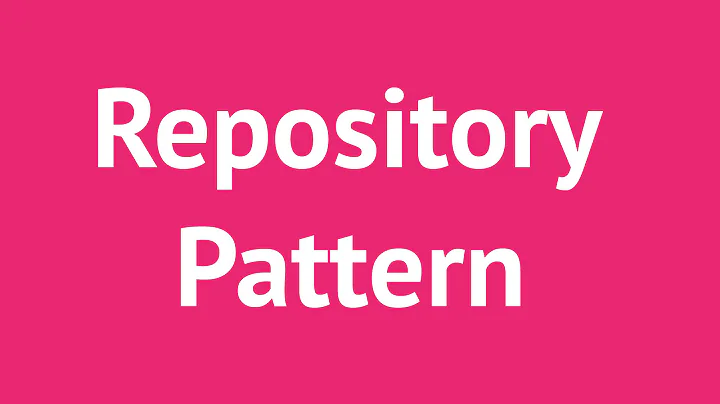Caching Data Objects when using Repository/Service Pattern and MVC
Solution 1
The easiest way would be to handle caching in your repository provider. That way you don't have to change out any code in the rest of your app; it will be oblivious to the fact that the data was served out of a cache rather than the repository.
So, I'd create an interface that the controllers use to communicate with the backend, and in the implementation of this I'd add the caching logic. Wrap it all up in a nice bow with some DI, and your app will be set for easy testing.
Solution 2
Steve Smith did two great blog posts which demonstrate how to use his CachedRepository pattern to achieve the result you're looking for.
Introducing the CachedRepository Pattern
Building a CachedRepository via Strategy Pattern
In these two posts he shows you how to set up this pattern and also explains why it is useful. By using this pattern you get caching without your existing code seeing any of the caching logic. Essentially you use the cached repository as if it were any other repository.
public class CachedAlbumRepository : IAlbumRepository
{
private readonly IAlbumRepository _albumRepository;
public CachedAlbumRepository(IAlbumRepository albumRepository)
{
_albumRepository = albumRepository;
}
private static readonly object CacheLockObject = new object();
public IEnumerable<Album> GetTopSellingAlbums(int count)
{
Debug.Print("CachedAlbumRepository:GetTopSellingAlbums");
string cacheKey = "TopSellingAlbums-" + count;
var result = HttpRuntime.Cache[cacheKey] as List<Album>;
if (result == null)
{
lock (CacheLockObject)
{
result = HttpRuntime.Cache[cacheKey] as List<Album>;
if (result == null)
{
result = _albumRepository.GetTopSellingAlbums(count).ToList();
HttpRuntime.Cache.Insert(cacheKey, result, null,
DateTime.Now.AddSeconds(60), TimeSpan.Zero);
}
}
}
return result;
}
}
Solution 3
Based on answer provided by Brendan, I defined a generic cached repository for the special case of relatively small lists that are rarely changed, but heavily read.
1. The interface
public interface IRepository<T> : IRepository
where T : class
{
IQueryable<T> AllNoTracking { get; }
IQueryable<T> All { get; }
DbSet<T> GetSet { get; }
T Get(int id);
void Insert(T entity);
void BulkInsert(IEnumerable<T> entities);
void Delete(T entity);
void RemoveRange(IEnumerable<T> range);
void Update(T entity);
}
2. Normal/non-cached repository
public class Repository<T> : IRepository<T> where T : class, new()
{
private readonly IEfDbContext _context;
public Repository(IEfDbContext context)
{
_context = context;
}
public IQueryable<T> All => _context.Set<T>().AsQueryable();
public IQueryable<T> AllNoTracking => _context.Set<T>().AsNoTracking();
public IQueryable AllNoTrackingGeneric(Type t)
{
return _context.GetSet(t).AsNoTracking();
}
public DbSet<T> GetSet => _context.Set<T>();
public DbSet GetSetNonGeneric(Type t)
{
return _context.GetSet(t);
}
public IQueryable AllNonGeneric(Type t)
{
return _context.GetSet(t);
}
public T Get(int id)
{
return _context.Set<T>().Find(id);
}
public void Delete(T entity)
{
if (_context.Entry(entity).State == EntityState.Detached)
_context.Set<T>().Attach(entity);
_context.Set<T>().Remove(entity);
}
public void RemoveRange(IEnumerable<T> range)
{
_context.Set<T>().RemoveRange(range);
}
public void Insert(T entity)
{
_context.Set<T>().Add(entity);
}
public void BulkInsert(IEnumerable<T> entities)
{
_context.BulkInsert(entities);
}
public void Update(T entity)
{
_context.Set<T>().Attach(entity);
_context.Entry(entity).State = EntityState.Modified;
}
}
3. Generic cached repository is based on non-cached one
public interface ICachedRepository<T> where T : class, new()
{
string CacheKey { get; }
void InvalidateCache();
void InsertIntoCache(T item);
}
public class CachedRepository<T> : ICachedRepository<T>, IRepository<T> where T : class, new()
{
private readonly IRepository<T> _modelRepository;
private static readonly object CacheLockObject = new object();
private IList<T> ThreadSafeCacheAccessAction(Action<IList<T>> action = null)
{
// refresh cache if necessary
var list = HttpRuntime.Cache[CacheKey] as IList<T>;
if (list == null)
{
lock (CacheLockObject)
{
list = HttpRuntime.Cache[CacheKey] as IList<T>;
if (list == null)
{
list = _modelRepository.All.ToList();
//TODO: remove hardcoding
HttpRuntime.Cache.Insert(CacheKey, list, null, DateTime.UtcNow.AddMinutes(10), Cache.NoSlidingExpiration);
}
}
}
// execute custom action, if one is required
if (action != null)
{
lock (CacheLockObject)
{
action(list);
}
}
return list;
}
public IList<T> GetCachedItems()
{
IList<T> ret = ThreadSafeCacheAccessAction();
return ret;
}
/// <summary>
/// returns value without using cache, to allow Queryable usage
/// </summary>
public IQueryable<T> All => _modelRepository.All;
public IQueryable<T> AllNoTracking
{
get
{
var cachedItems = GetCachedItems();
return cachedItems.AsQueryable();
}
}
// other methods come here
public void BulkInsert(IEnumerable<T> entities)
{
var enumerable = entities as IList<T> ?? entities.ToList();
_modelRepository.BulkInsert(enumerable);
// also inserting items within the cache
ThreadSafeCacheAccessAction((list) =>
{
foreach (var item in enumerable)
list.Add(item);
});
}
public void Delete(T entity)
{
_modelRepository.Delete(entity);
ThreadSafeCacheAccessAction((list) =>
{
list.Remove(entity);
});
}
}
Using a DI framework (I am using Ninject), one can easily define if a repository should be cached or not:
// IRepository<T> should be solved using Repository<T>, by default
kernel.Bind(typeof(IRepository<>)).To(typeof(Repository<>));
// IRepository<T> must be solved to Repository<T>, if used in CachedRepository<T>
kernel.Bind(typeof(IRepository<>)).To(typeof(Repository<>)).WhenInjectedInto(typeof(CachedRepository<>));
// explicit repositories using caching
var cachedTypes = new List<Type>
{
typeof(ImportingSystem), typeof(ImportingSystemLoadInfo), typeof(Environment)
};
cachedTypes.ForEach(type =>
{
// allow access as normal repository
kernel
.Bind(typeof(IRepository<>).MakeGenericType(type))
.To(typeof(CachedRepository<>).MakeGenericType(type));
// allow access as a cached repository
kernel
.Bind(typeof(ICachedRepository<>).MakeGenericType(type))
.To(typeof(CachedRepository<>).MakeGenericType(type));
});
So, reading from cached repositories is done without knowing about the caching. However, changing them requires to inject from ICacheRepository<> and calling the appropriate methods.
Related videos on Youtube
LaptopHeaven
Updated on August 20, 2020Comments
-
 LaptopHeaven over 3 years
LaptopHeaven over 3 yearsI have an MVC-based site, which is using a Repository/Service pattern for data access. The Services are written to be using in a majority of applications (console, winform, and web). Currently, the controllers communicate directly to the services. This has limited the ability to apply proper caching.
I see my options as the following:
- Write a wrapper for the web app, which implements the IWhatEverService which does caching.
- Apply caching in each controller by cache the ViewData for each Action.
- Don't worry about data caching and just implement OutputCaching for each Action.
I can see the pros and cons of each. What is/should the best practice be for caching with Repository/Service
-
 LaptopHeaven over 15 yearsHow can I do this and keep the Repositories and Services agnostic? I would like to reuse the R/S for other non-web applications.
LaptopHeaven over 15 yearsHow can I do this and keep the Repositories and Services agnostic? I would like to reuse the R/S for other non-web applications. -
 Admin over 15 yearsHmmm.... I don't see an issue here. You can create a standard Repository or a CacheableRepository that takes an ICache dependency (whatever that may be). Just because you're "caching" doesn't mean you MUST use httpcache
Admin over 15 yearsHmmm.... I don't see an issue here. You can create a standard Repository or a CacheableRepository that takes an ICache dependency (whatever that may be). Just because you're "caching" doesn't mean you MUST use httpcache -
 Admin over 15 yearsYou can implement an ICache that uses the ASP.NET cache (which, btw, can be used in a winforms or any other app), or that uses the P&P group's cache, or your own cache implementation.
Admin over 15 yearsYou can implement an ICache that uses the ASP.NET cache (which, btw, can be used in a winforms or any other app), or that uses the P&P group's cache, or your own cache implementation. -
 Mister Q about 7 yearsNice work! up voted because of the generic approach :)
Mister Q about 7 yearsNice work! up voted because of the generic approach :) -
 Bruno Martins about 2 yearsthanks for sharing, here is the last Steve Smith blog post about this subject, using net core : Building a CachedRepository in ASPNET Core
Bruno Martins about 2 yearsthanks for sharing, here is the last Steve Smith blog post about this subject, using net core : Building a CachedRepository in ASPNET Core



![[ASP NET] Ep01 - Ứng Dụng Kiểu Mẫu Repository Và Unit Of Work Trong Hệ Thống - Phần 1](https://i.ytimg.com/vi/nhAc5Yzf4bk/hq720.jpg?sqp=-oaymwEcCNAFEJQDSFXyq4qpAw4IARUAAIhCGAFwAcABBg==&rs=AOn4CLDZthc7J3OBS8HenYCaWkbDbLPW3A)



